Today, we’re talking about how to keep cinnamon swirl bread from separating and gapping when baked.
Unlike cinnamon rolls that are gooey and fun to unroll to eat, a slice of bread that unravels when you try to slice it for toast is no good for anyone.
I’ll show you two ways to prevent gapping and delamination, tell you which is my favorite and why, and share a tasty cinnamon bread recipe with you.
Pastry Chef Online Participates in Affiliate Programs. If you make a purchase through one of my links, I may earn a small commission. For more information click to read my disclosure policy
For ease of browsing, you can find all my bread recipes in one place. Let’s get into it.
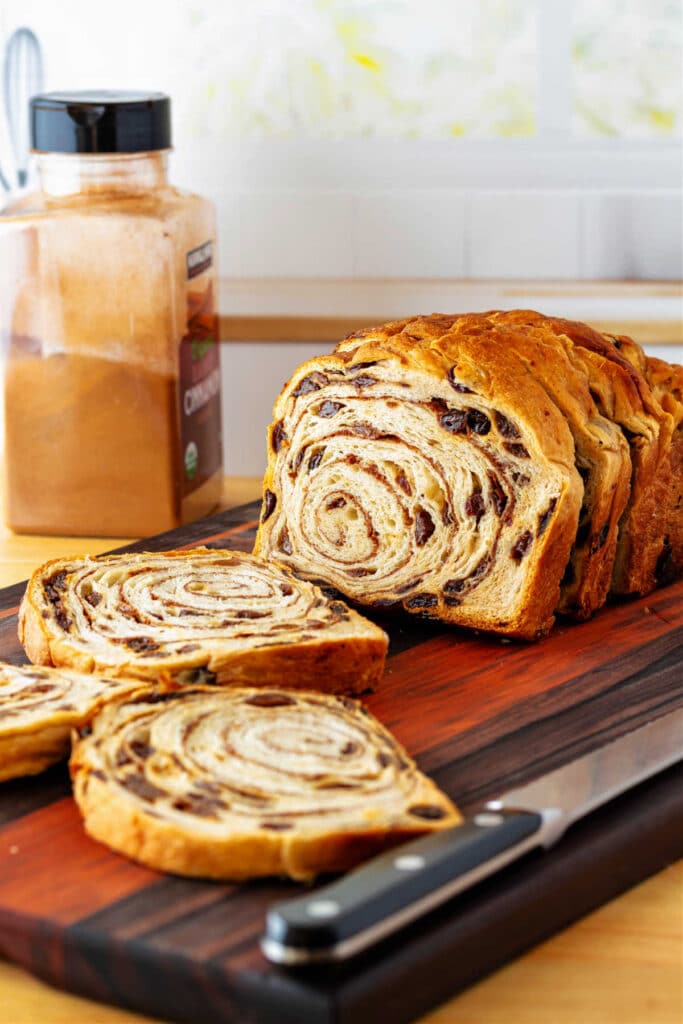
Reader Question
Phyllis recently sent in this question:
I love to make cinnamon raisin bread. I normally roll out the dough and spread it with butter, cinnamon, sugar and raisins. Then I would roll it up and bake it. After it is baked, the dough inside has separated with lots of space between where it was rolled. How can I achieve a pretty slice of cinnamon raisin bread?
I did a bit of reading up on this problem.
In my reading about cinnamon swirl bread, I came across several blog posts in which the bread had clearly not stuck together. There were gaps between all the layers, or some of the layers, and a few of them looked like if you held a slice up by the end of the spiral, it would unravel or spring open like a sproinged slinky.
Of course the bread will still be delicious, but sometimes it’s nice to have a slice of bread stay a slice of bread, you know?
Why Does Cinnamon Bread Separate?
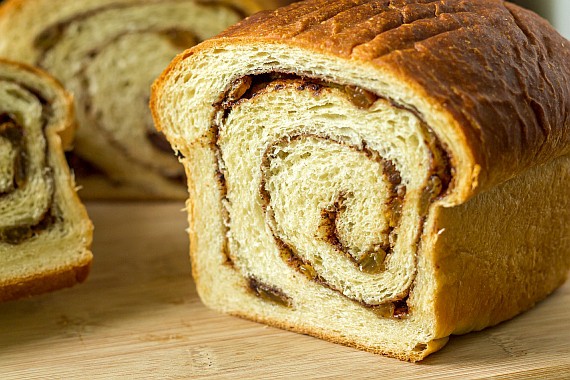
Before we get into all the ins and outs, we need to understand why this gapping/separating/delamination happens.
There are two main reasons that swirl in cinnamon bread (and other swirled “stand alone breads” as opposed to cinnamon rolls) tends to gap open.
- The first is that the steam from the dough and filling coupled with the gases emitted by the yeast pushes out and up, smooshing your layers and leaving a noticeable gap often under the top layer of your swirled bread.
- The other issue is that there is no sticking power in the swirl. Most folks slather on butter and then their sugar and cinnamon and the fat makes everything slippery so the layers can’t bind. Fixing the binding problem also fixes the gas issue and you’ll also end up with a lighter bread that has great oven spring and rise.
It sounds so simple, right? Honestly, when it has happened to me in the past, I chalked it up to overproofing, figuring it rose too high and then collapsed.
And that could be one of the issues. Obviously, it wasn’t something that I felt the need to look into, but once I started snooping around for Phyllis, I really wanted to smack myself in the head (thanks, Phyllis) and exclaim, “Why didn’t I think of that?!”
How To Keep Cinnamon Bread from Separating
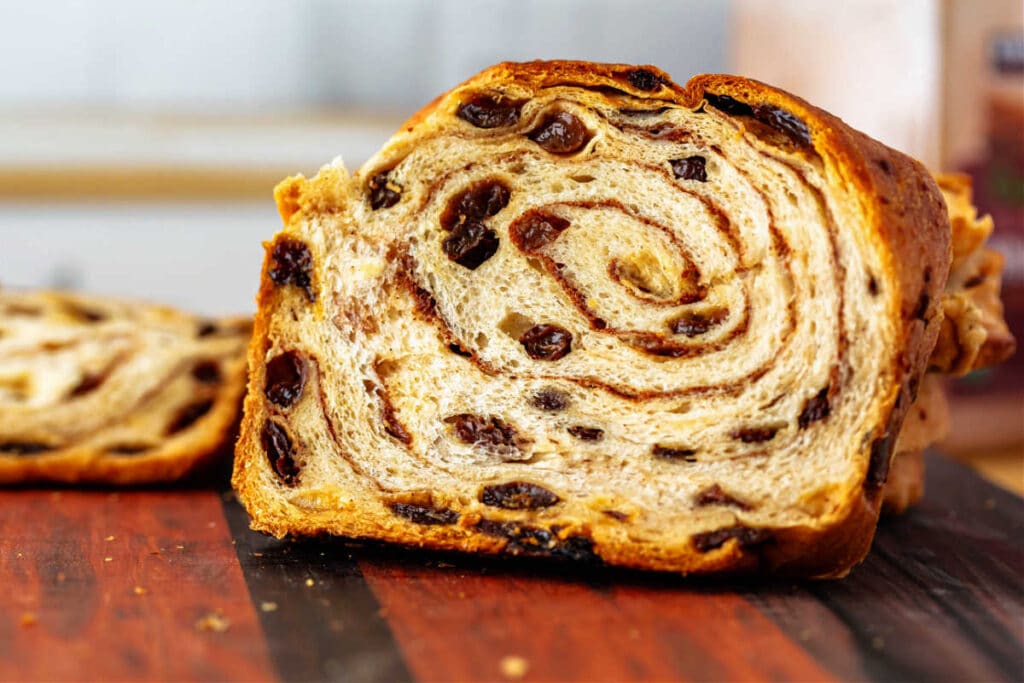
What follows is an update after I made gorgeous cinnamon raisin bread that was perfectly laminated.
There are two main methods to keep your swirls from delaminating, or to put a positive spin on it, that ensure your slices of swirl bread are perfect.
- Using starch as a binder
- Using egg as a binder
The Starch Method
This is now my go-to and much preferred method of keeping the swirls in cinnamon bread from separating.
My “new” swirl recipe is equal parts flour and sugar plus cinnamon and a pinch of salt.
For one loaf, that generally translates to 2 Tablespoons each of flour and granulated sugar, 4 1/2 teaspoons cinnamon, and a pinch of salt.
How The Starch Method Works
Butter sticks to…nothing. So using butter in the swirl is right out.
What does stick to dough, though, is more dough.
When you mix flour, sugar, and cinnamon together, you have the dry ingredients of a dough.
Add to that a liberal brushing of your dough with milk, you have the liquid you need to make a thin cinnamon “dough” that will yield beautiful swirls that hold together, even when thinly sliced.
Here’s how to do it:
- Roll dough out into a long, thin rectangle, and liberally brush the entire surface with milk.
- Whisk together your swirl ingredients and then spread them evenly onto the wet dough, pressing down to moisten the flour and sugar as much as possible.
- Roll up the dough under light tension–pulling back on the roll every couple of rolls to ensure a tight roll.
- Pan, rise, and bake.
- Cool, slice (thinly, if you want), and enjoy.
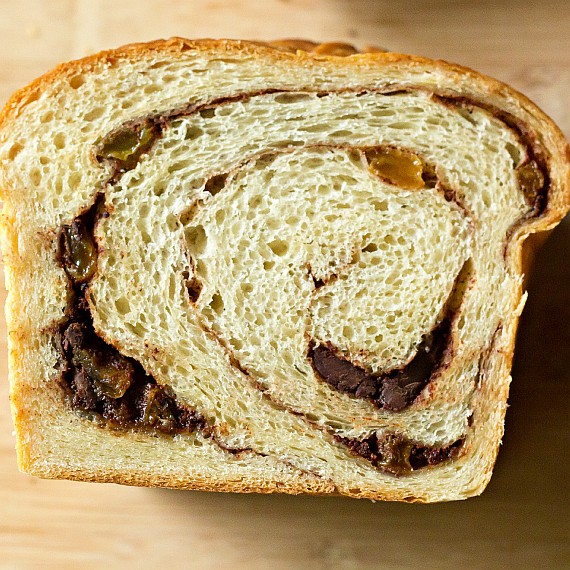
The Egg Method: My Runner-Up
The egg method is where you mix a beaten egg together with the swirl ingredients (sugar, cinnamon, salt) and spread that thinly on your rectangle of dough.
The egg acts as glue, binding the swirl to the dough, resulting in minimal if any delamination.
Why It’s My Runner-Up
The method works well, if you’re not allergic to eggs.
Especially if you’re making an egg-free loaf, why introduce egg when you don’t have to?
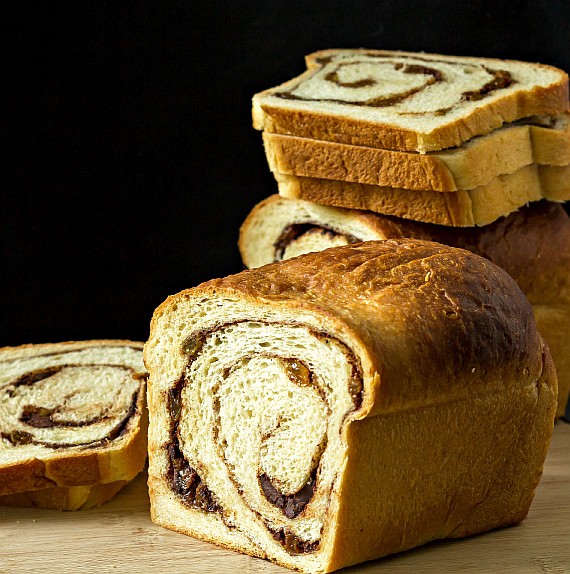
Add Your Mix-ins To the Dough and Not the Swirl
Another excellent tip for keeping your swirl together is to not add the “chunky bits” such as raisins, nuts, or chocolate chips, to get in the way of the binding.
Knead any mix-ins into the dough itself and leave the swirl smooth. Just cinnamon, flour (or egg, if that’s your preferred method), sugar, and salt.
Even with the best “glue,” you will end up with some delamination around the mix-ins. See the photo above where I used raisins and chocolate chips and added them directly to the swirl.
Delicious, but a bit of a clumpy mess. Knead those into the dough. I learned my lesson so you don’t have to make the same mistake as me!
Reader Review
Reader Helen reached out with this wonderful review of this bread and the method for keeping it from separating. Here’s what she said:
Found this recipe for Cinnamon Bread claiming it wouldn’t separate layers if the directions were followed. Tried it yesterday, and it worked exactly as the claim stated. I love you Pastry Chef Online for solving my dilemma of the separating layers in my Cinnamon Bread . . . I even went all out and used this recipe instead of the one I’ve been using for years . . . Two words describe it: YUMMY and BEAUTIFUL. Thank you so very much Chef Jenni. I’m not a FB user otherwise I’d post out there.
Reader Helen Chapman
I know you too will find success using either one of the methods I outline in this post! Thank you for commenting, Helen. It means the world to know I’m helping!
More Answers to Baking Questions
If you’re the kind of person who likes to understand why things happen and why methods work rather than just knowing the steps for doing things, you may enjoy the answers to these baking questions:
- Do I Really Have to Sift Flour?
- What Do Eggs Do In Baking?
- What Is The Creaming Method and Why We Use It
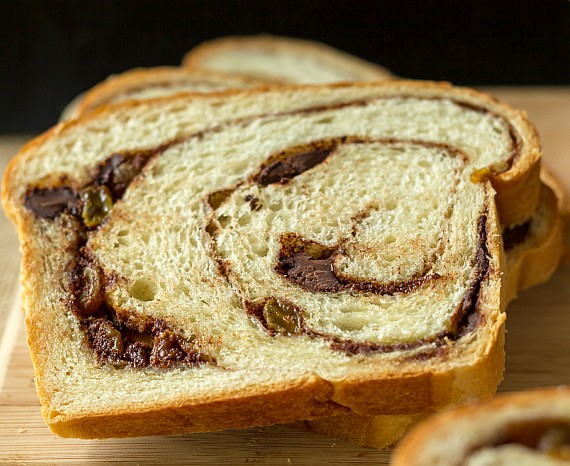
Reader Rave
Perfect! Made this bread last night, following your recipe to a T, and it could not have turned out any better. The dough was a joy to work with and the taste is so yummy. Thank you for sharing your recipe. I love it and now have a favorite, go to recipe source.
Reader Patti
If you have any questions about this post or recipe, I am happy to help.
Simply leave a comment here and I will get back to you soon. I also invite you to ask question in my Facebook group, Fearless Kitchen Fun.
If your question is more pressing, please feel free to email me. I should be back in touch ASAP, as long as I’m not asleep.
A Note About Measurements
My recipes are almost all written by weight, including liquids, unless otherwise specified.
For accuracy and consistency of results, I encourage you to buy–and use–a kitchen scale.
I promise that baking and cleanup will be so much quicker and easier.
This is the scale that I recommend for home use. I have owned and used one for years.
Don't let its small price and small size fool you. The Escali Primo is an accurate and easy-to-use food scale that I have used for years. It's easy to store, easy to use, has a tare function, and easily switches between grams and ounces/pounds for accurate measurements.
It will help me and other readers so much if you take a moment to rate and leave a review for this recipe.
You can use the stars to rate 1-5 (5 is best), and leave a review in the comments. It helps me make adjustments if any are needed, and comments help others decide whether the recipe is worth making.
Other ways to share include pinning, and/or sharing on your favorite social media platform.
Thank you so much for taking the time!

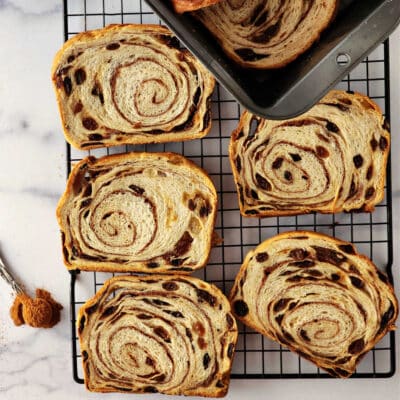
Cinnamon Bread Recipe
Ingredients
For the Bread
- 1 Tablespoon active dry yeast 15 grams
- 17 oz lukewarm water 482 grams, or 2 cups plus 2 Tablespoons
- 25.5 oz all-purpose flour 723 grams, or 6 cups measured by the scoop and sweep method
- 2.5 oz granulated sugar 71 grams or 6 Tablespoons
- 2 ½ teaspoons fine sea salt 13 grams
- 6 oz very soft unsalted butter 170 grams or 12 Tablespoons
- 2.5 oz malted milk powder 70 grams or 1/2 cup
- 3 oz instant mashed potato flakes 86 grams or 1 cup
- 1 cup raisins or a mixture of raisins and chocolate chips (completely optional)
For the Swirl Using Flour
- 7.5 oz brown sugar 213 grams or 1 cup, packed
- 4 oz all-purpose flour 113 grams or a scant cup
- 8 teaspoons cinnamon
- pinch salt
- 4 oz milk
For the Swirl, Using Egg
- 7.5 oz brown sugar 213 grams or 1 cup, packed
- 8 teaspoons cinnamon
- pinch salt
- 1 egg beaten
Instructions
For the Dough
- Add all the dough ingredients to your mixer fitted with the dough hook.
- Mix on low until the dough comes together and then knead on medium-low speed until the dough is smooth and silky and passes the windowpane test, about ten minutes. The finished dough should be soft but not sticky.
- (OPTIONAL) If using mixins like nuts, chocolate chipis, or raisins, knead in on low speed on the mixer for 2 minutes, and then finish kneading them in evenly by hand.
- Shape the dough into a ball and put it back in your mixer bowl. Spray the top with pan spray and then cover and let rise in a warm place until doubled in bulk, about 1 1/2 hours. I let mine rise in the microwave with the stove light on. This keeps the bottom of the microwave nice and warm and gives the bread a nice, enclosed, draft-free place to rise. You can add a mug of hot water if things seems to be progressing slowly.
- When doubled, turn the dough out on your work surface and divide the dough in half. For precision, weigh the dough and divide accordingly. My dough weighed in at 56.5 oz, so I divided my dough into two 28.25 oz pieces.
- Roll each piece into a smooth ball and place smooth side down on the counter. Roll or press the dough out until you have a long rectangle about 6″ wide and at least 18″ long. The longer you make your rectangle, the more swirls your bread will have, so it’s completely up to you and how much patience you have.
To Add the Flour-Based Swirl
- Whisk together all the dry ingredients (brown sugar, flour, cinnamon, and salt.
- Liberally brush each rectangle of dough with the milk, then evenly sprinkle half the swirl on each piece of dough. Press down to moisten the flour mixture to help it adhere.
- Roll up each rectangle, keeping light tension on the dough as you roll. Pinch the seams well.
To Add the Egg-Based Swirl
- Whisk the egg, sugar, cinnamon, and salt together into a paste.
- Evenly spread half the filling on each loaf and then roll up as indicated above.
- Place the finished loaves, seam side down, in an 8 1/2" x 4 1/2" baking pan. You can bake in 9"x5" pans, but your bread won't be quite so tall. Again, it's completely up to you.
- Preheat the oven to 350F.
- Spray your loaves lightly with pan spray and cover them. Let rise until the dough peeks over the tops of the pans by 1-1 1/2″, about 45 minutes.
- Bake on the center rack until deeply golden brown with an internal temperature of 200F, about 40-50 minutes depending on your oven. If the loaves are starting to brown too much, loosely tent them with foil for the last 20 minutes or so of baking.
- Remove the loaves from the oven, carefully turn out onto rack and cool to room temperature before slicing. But do heat or toast the bread for serving. So good!
Did You Make Any Changes?
Notes
Nutrition
And I think that does it. Thanks so much for taking the time to read, and here’s to gapless loaves of cinnamon swirl bread for all of us from now on.
Take care, and have a lovely day.
References
- Cinnamon Swirl Bread from King Arthur
- Discussion of the Issue on StackExchange
- Gap in Cinnamon Loaf Discussion at The Fresh Loaf
- Cinnamon Swirl Bread from The Galley Gourmet (method of brushing milk/vanilla on both sides of the dough)
- Discussion of why cinnamon bread separates on Cooking Light Forum

Hi, y’all! I hope you’ve enjoyed this post and hopefully also learned a thing or two.
If you like my style, I invite you to sign up for my occasional newsletter, The Inbox Pastry Chef.
Expect updates on new and tasty recipes as well as a bit of behind-the-scenes action. I hope to see you there!

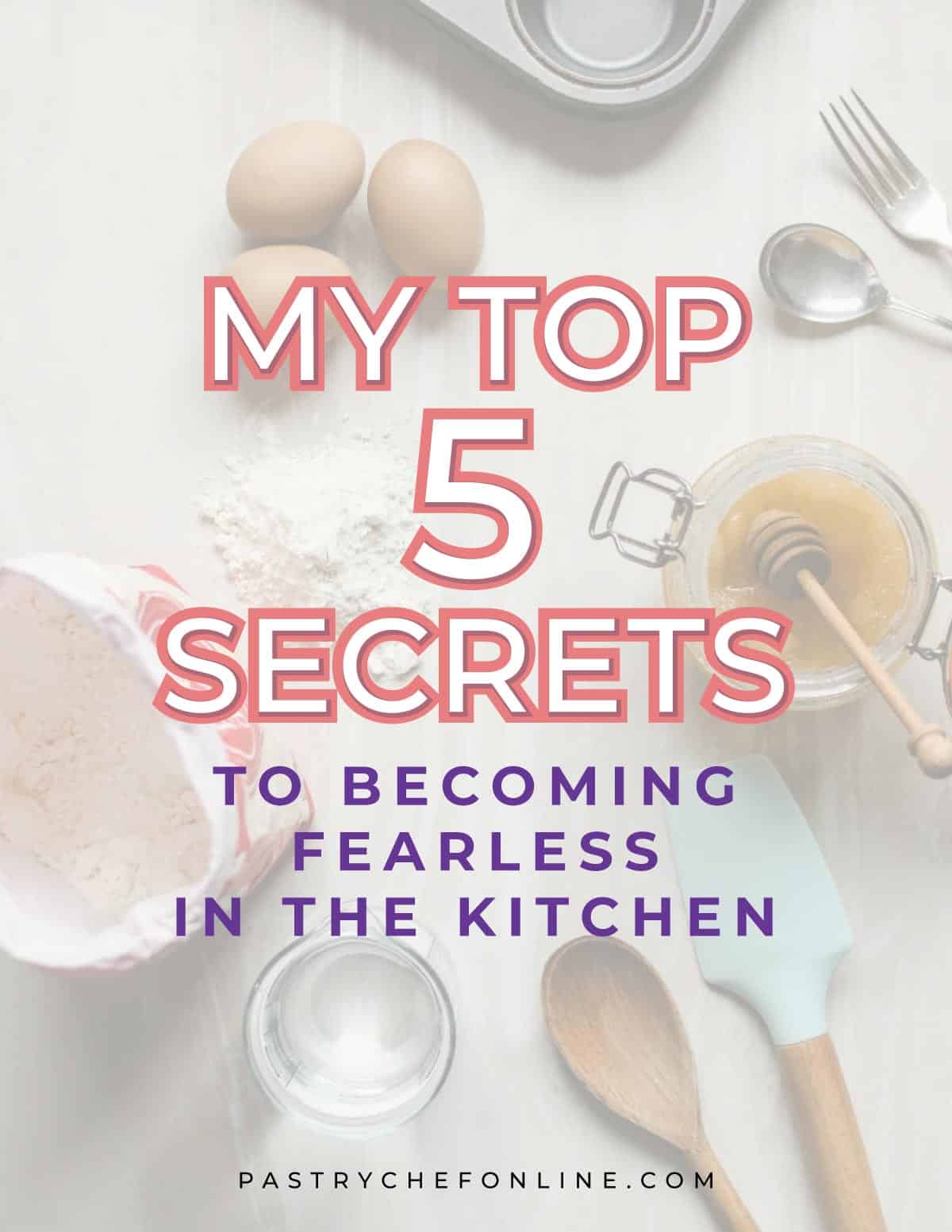
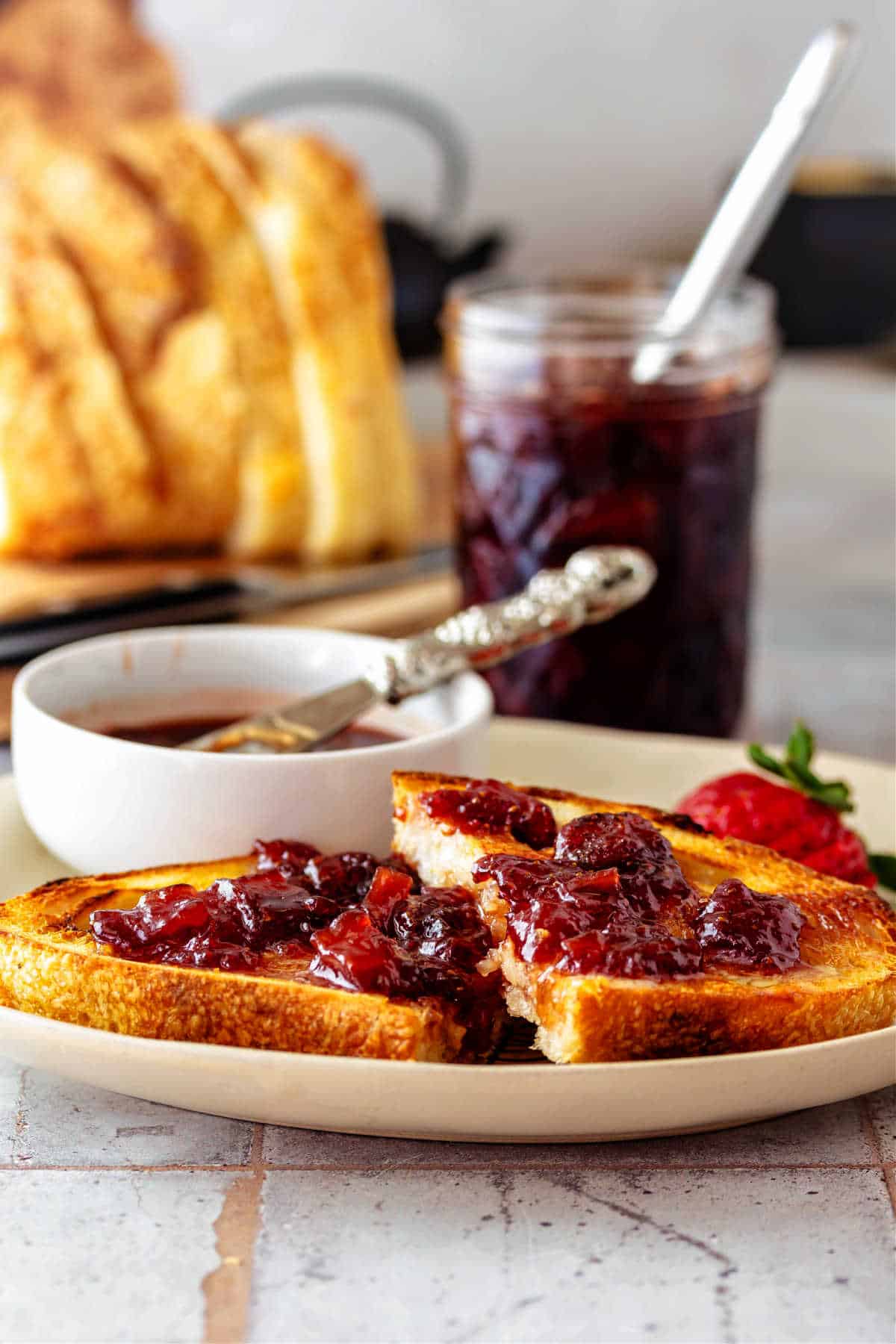
Join in Today!
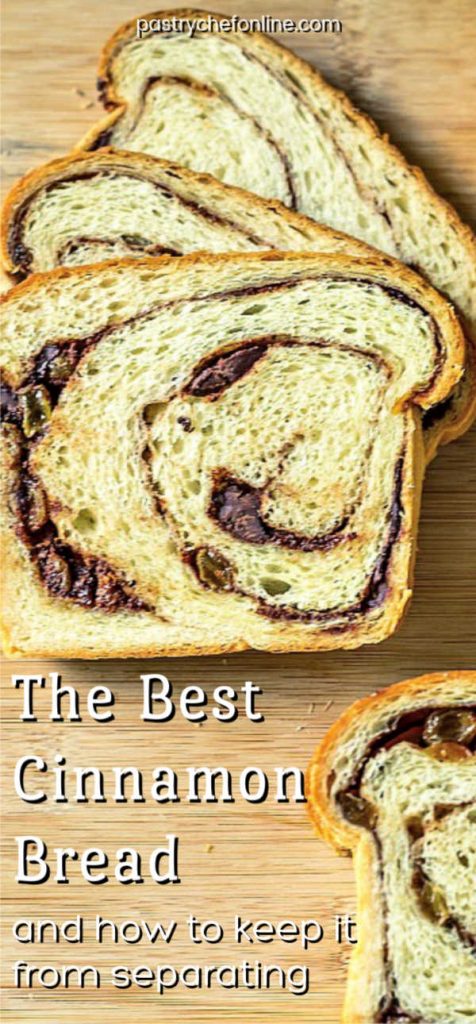
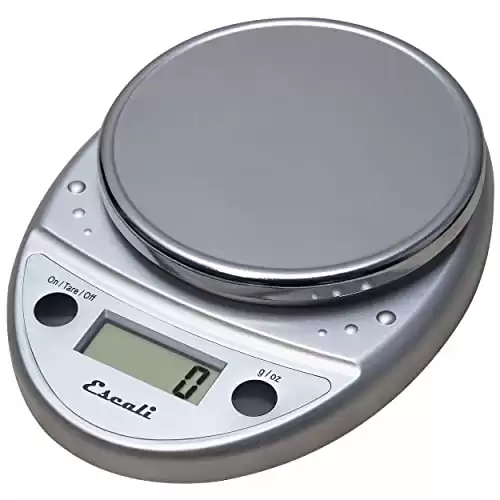
Hi!
So glad I ran into this article to help me with my purse cinnamon bread! We don’t eat eggs so thank you, thank you, thank you, for including the starch method! Question…any starch works? Potato, tapioca or cornstarch? Also, I mix the raisins with the flour when making the dough before the first rise. The filling I use is just cinnamon and brown sugar. The recommendation of 2tsp of starch per 1/4 cup of sugar…the filling calls for 3tbsp of brown sugar(so just under 1/4cup) and 1tbsp of ground cinnamon, do I add 2tsp of starch AND 2tsp of powdered sugar? So 4tsp total to the filling?
Hey, Yuri! I’m glad you found it helpful. 🙂 Any starch should work although I’ve only used flour. Still, all starches swell at around the same temp and function in similar ways, so any should work. I think between the powdered sugar and starch, I’d just go with starch. Add maybe 1 Tablespoon flour. You can even consider adding just enough milk or water to turn the filling into a thick, spreadable paste.
Thank you for your prompt response! I added 1tbsp of cornstarch to my filling and it worked like a charm!!!
I am so pleased! Yay!
Found this recipe for Cinnamon Bread claiming it wouldn’t separate layers if the directions were followed. Tried it yesterday, and it worked exactly as the claim stated. I love you Pastry Chef Online for solving my dilemma of the separating layers in my Cinnamon Bread . . . I even went all out and used this recipe instead of the one I’ve been using for years . . . Two words describe it: YUMMY and BEAUTIFUL. Thank you so very much Chef Jenni. I’m not a FB user otherwise I’d post out there.
Oh, Helen, your comment made me well up! I am so pleased the bread turned out well and that you no longer have to worry about separating layers! Have a wonderful holiday, and thank you, sincerely, for your comment. Made my day!